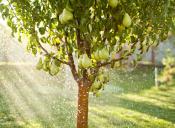Search
Login
Ornamental and medicinal plants on the site. Yucca: how to grow, make bloom and keep in winter in central Russia
Such a garden plant as a yucca easily outperforms many decorative inhabitants of the garden with its external data. Its picturesque and exotic appearance gives the landscape sophistication and charm. Yucca tree attracts the attention of even the most demanding connoisseur. This plant was first brought from America, and the first flower appeared in the gardens of the Old World in the sixteenth century. Simple types of yucca palm trees in those days grew in South and North America, Mexico, Guatemala, and the islands of the Atlantic Ocean. Once in Europe, garden yucca quite widely and quickly gained popularity in all countries.
Content
- Habitat and species of yucca video
- Yucca garden planting and care video
- How to root yucca
- Wintering yucca filamentous
- Plant in landscape design
- Pests and diseases
Habitat and species of yucca

This type of palm tree is very unpretentious, tolerates frosts perfectly, it can be without moisture for a long time. With the onset of the twentieth century, about ten varieties of garden yucca took root on the Black Sea coast. Today, the yucca palm is a popular and widespread type of ornamental plant cultivated in the Crimea and the Caucasus.

Two types of yucca mainly grow in central Russia: the glorious yucca and the yucca filamentous. The most frost-resistant palm of them is the filamentous yucca. This tree growing in the garden and having shelter will calmly survive frosts up to - 30 degrees. This type of garden palm grows well both indoors and outdoors.
The glorious yucca, also growing in Russia, belongs to more heat-loving plants, that is, it can be grown on the street, but in warmer regions of the country.
Many people attribute this exquisite plant to palm trees, which is understandable in principle. With its appearance, leafy foliage and a brownish trunk, it really resembles a palm tree, but nevertheless it belongs to plants of the agave family. It can grow as a small tree or as a shrub. The cultivated plant reaches a height of 30 cm to 2.5 m. At home, Yucca has less chance to give flowering, growing it in the garden is an excellent opportunity for active development, growth and flowering, of course, if there is definitely a certain amount of light and heat.

Yucca usually blooms when grown in the open, in the third year of its life. The flowers of this plant are very beautiful, in shape resemble a bell, in color - snow-white. The desire to grow this plant in his garden appears after the gardener sees the yucca flowers in the photo - they look simply amazing.
The number of flowers reaches two hundred, and this is only on one leg! The flowering period is quite long - reaches three weeks, which significantly increases the decorative qualities of the plant. But, unfortunately, in the case of a very cold winter, damage occurs to the part of the plant located above the ground, which in turn can lead to a lack of flowering.
Yucca also has fruits, but they occur exclusively on those plants that grow in the southern countries of the planet. This happens because pollination is performed by small butterflies, whose habitat is not our regions.
It makes sense to note that in general in nature there are more than three dozen species of this culture, but in our area only two are cultivated and grown - glorious yucca and filamentous.
Yucca garden planting and care

The cultivation of different types of yucca in the garden occurs using cuttings that are separated from the adult plant. In order to get a stalk, it is necessary to separate from the lateral or upper shoots of the branch, at least twenty centimeters in length, which subsequently sprout: either in water for irrigation without soil, or in soil, with nutrients. There is another way of breeding - seeds, which must undergo stratification. Using the last method of breeding, seedlings obtained from seeds are germinated for two to three years in the room, waiting until it is fully strengthened and ready for transplantation into the soil.
How to root yucca
When planting this culture in your garden, identify the warmest and sunniest place for it. Although, if such a place is not found, then a place with a small penumbra will also do. Recommended air temperature during transplantation should not be below eighteen degrees during the day and less than seven degrees at night.

The land for yucca should be nutritious and with drainage, and acidity should be 5.5 to 7.5 pH. If the soil on your household plot is not sufficiently fertilized, you need to dig a pit for planting in advance, with a minimum size of 50x50x50 cm.Then fill it with a mixture of humus, sand, peat and garden soil, observing a 1: 1: 1: 1 proportion. A transplant into the ground is done in the spring.

Prior to this, the seedlings are kept in a box on a windowsill or in a greenhouse. On the eve of planting in open ground, the seedling must be a little tempered. Hardening occurs as follows - every day you need to take out a box with a seedling on the street, daily increasing the time spent in open space. The hole for planting should have a size of at least two times the size of the root of the plant itself.
After planting is completed, the earth around the seedling needs to be watered a little. Subsequent care comes down to watering, constant nourishment and protection against diseases. Since yucca tolerates drought well enough, but does not tolerate dampness, it should be watered only when the soil dries. If the ground under the plant is slightly damp - no need to water.
Water only completely dry land under this crop.
If the leaves are dry on the yucca, spray the surface of the leaves with a spray gun. The best time of day for this procedure will be evening.
Specialists advise fertilizing the soil under yucca annually. Do it mainly in the spring. In the form of fertilizers use all kinds of complex means for succulents.
In winter, at a temperature of -12 degrees, this plant will feel great. Also, it can survive almost minus 24 painlessly, at a whiter low temperature, it should be wrapped in polyethylene. Mulching is done on the piece of land that covers the root system.
Wintering yucca filamentous
Filamentous yucca, in principle, does not take root well and grows in territories with our climatic conditions and blooms almost annually. But there are different opinions about whether it makes sense to plant it, whether it will take root or not, whether it will bloom. In any case, until you plant, you will not know.

Specialists confirm with confidence that it will grow and bloom. The main thing is to follow the rules of planting, watering and top dressing. Even if in the early years, for example, due to the fact that it froze and does not bloom, believe me, over time it will grow and will please with its peduncles, and then with snow-white, beautiful flowers.
The flowering conditions of yucca are simple:
- compliance with the rules of care,
- planting in a well-lit place
- successful wintering
- and moderate watering.
Only an adult plant that has reached the age of three can please flowering.
It will take some measures to increase the frost resistance of the plant. In the fall, from mid-October to mid-November, you can do the following:
- in dry weather, collect the leaves and tie them in a tight bunch using a rope, you need to tie the rope from the bottom to the top,
- we do not tie the three lowest layers of leaves into this bunch, but leave them on the ground for additional protection of the root system,
- we cover the base of the flower with a thick layer of dry foliage, press it with boards, so that the wind does not violate this layer.
There is another option for improving frost resistance:
- collect and bind all the leaves
- the foundation is covered with a layer of earth twenty centimeters thick,
- with the onset of spring - remove the layer, untie the leaves,
- for some period of time do not touch anything, wait.
Soon, young foliage will begin to appear. Some of the leaves that survived the winter may begin to turn yellow and dry - they should be cut off. Due to different winter weather conditions, the leaves can also freeze in different quantities, but you should not worry - but from the middle of the bush, young foliage will always grow. The best time to divide, transplant or plant this crop is the spring season. No need to be afraid to transplant a yucca, this procedure, it will survive well thanks to the relatively thick base of the root system, which contains many nutrients and a sufficient amount of moisture. Even in the hottest weather, watering should be done no more than once a week. This will be enough.
Plant in landscape design

The garden yucca looks not ordinary in form and very luxuriously blooms. With proper care and suitable soil, the yucca will grow large. This tree will look gorgeous against the background of stones in a single landing. Yucca can also grow in the neighborhood with other shrubs and trees. But it is worth noting that not every plant is suitable for this tree in the neighbors. It will not be a bad composition if you put gypsophila, lavender, rue, and irises around a street yucca.

We emphasize that the best environment for a garden yucca would be flowers and other plants not of a catchy appearance, but rather modest. Surrounded by vibrant flowers and curly foliage, the yucca with its hard leaves will look rude. Yucca Gardens surprisingly changes during flowering. Yucca is blooming. Traditionally, it begins to bloom in late June and early July. The first flowering occurs in 3-4 years of life, when it gained enough strength and the root system developed and strengthened well.
Good enough, this plant will coexist and look on the background with cereal crops. These are great variations for landscape design.
Pests and diseases

Like many other plants, yucca can also hurt and be damaged by pests. For example, with excessive moisture in the cold, winter period, yellow spots may appear on the leaves. Often, in this way a lack of light can occur.
Of the pests, it is necessary to note the scale and slugs. The fight against slugs is reduced to the use of conventional insecticides. But with a shield a little more complicated. In order to get rid of this insect, you need to daily wipe the leaves with a wet cotton sponge. If this does not help, then you can wipe once a week not with water, but with vodka.






